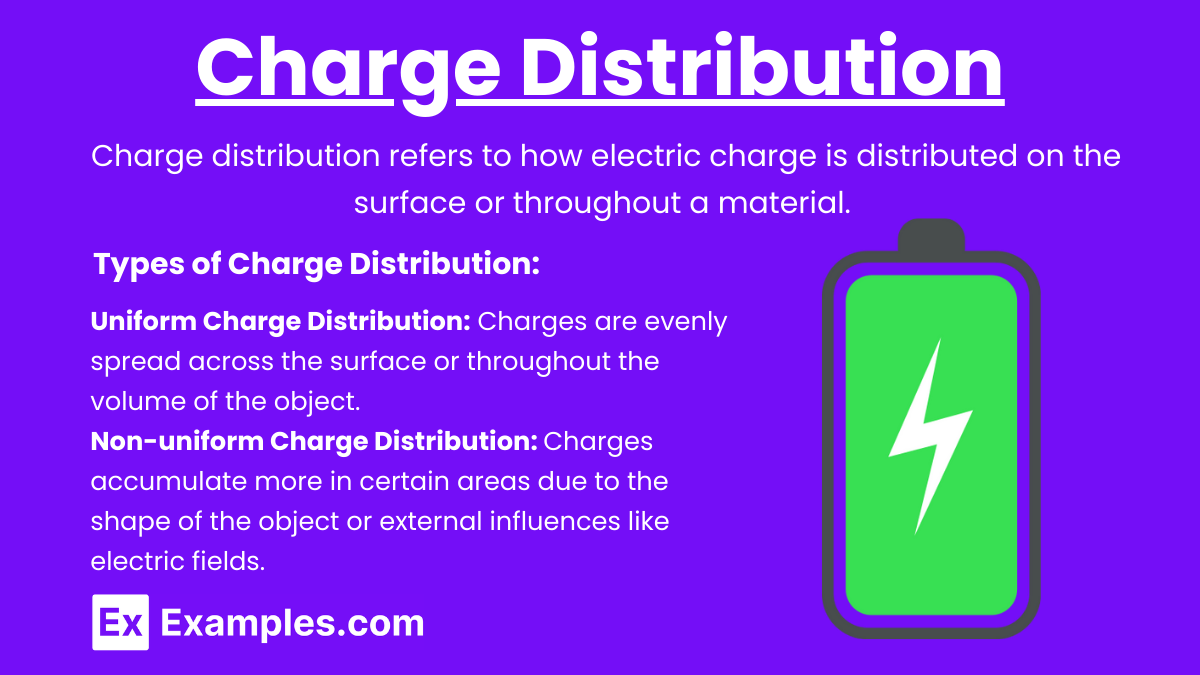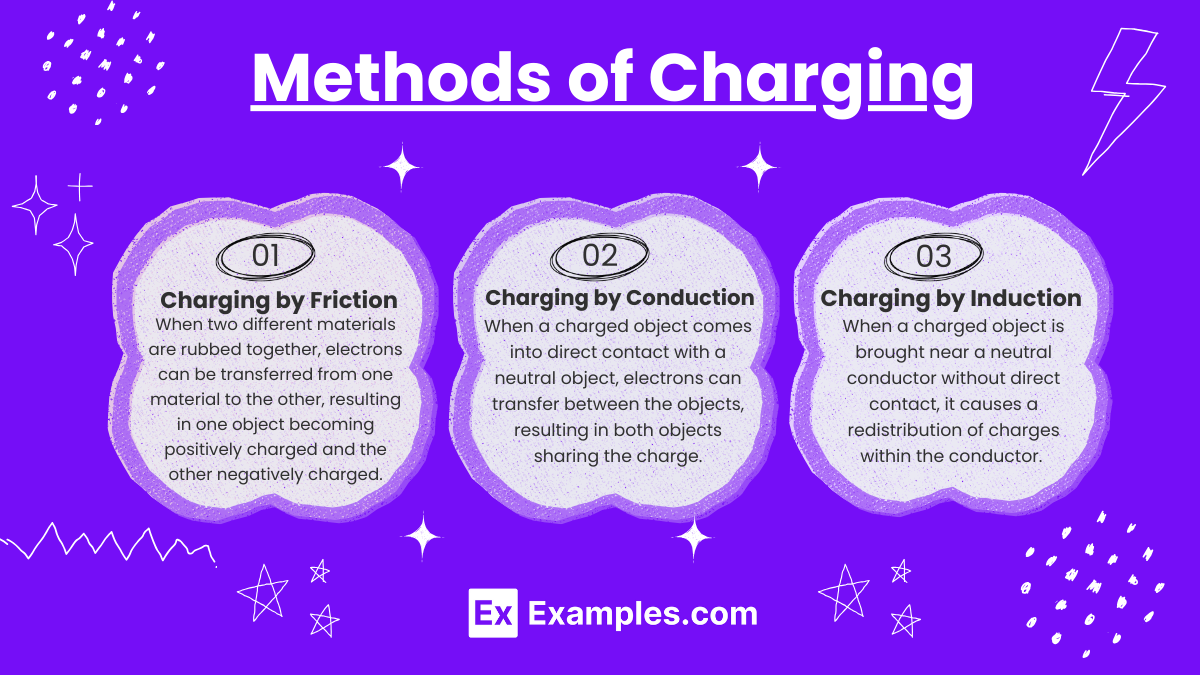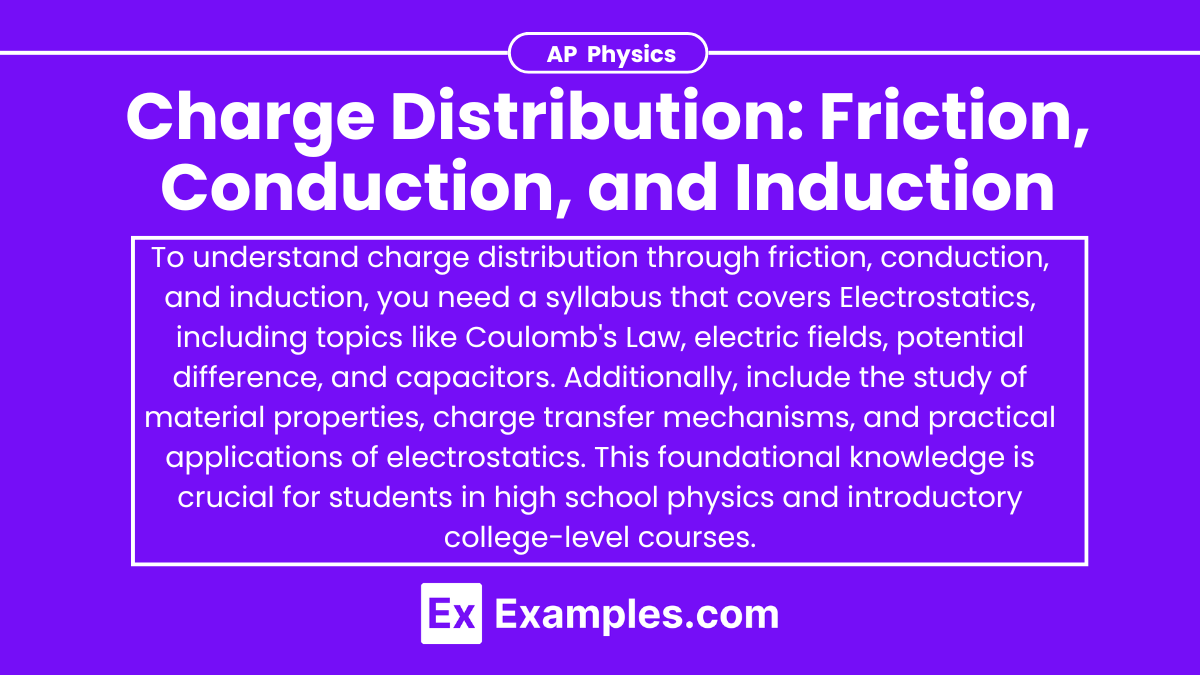Understanding charge distribution and the methods of charging by friction, conduction, and induction is crucial for mastering electrostatics in the AP Physics exam. These topics cover how charges are transferred and distributed on objects. Below are detailed notes along with five examples to help you achieve a high score on your AP Physics exam.
Learning Objectives
By studying charge distribution through friction, conduction, and induction for the AP Physics exam, you should learn how objects become charged through different methods, understand the movement of electrons in each process, and predict the resulting charge distribution. You will also be able to explain the principles of electrostatics, apply the concept of conservation of charge, and solve related problems. Mastery of these topics will enhance your understanding of electric forces and fields in various scenarios.
Charge Distribution

Charge Distribution: Charge distribution refers to how electric charge is distributed on the surface or throughout a material. Charges can be distributed uniformly or non-uniformly depending on the shape and material of the object.
Types of Charge Distribution
- Uniform Charge Distribution:
- Charges are evenly spread across the surface or throughout the volume of the object.
- Non-uniform Charge Distribution:
- Charges accumulate more in certain areas due to the shape of the object or external influences like electric fields.
Methods of Charging

1. Charging by Friction
Charging by Friction: When two different materials are rubbed together, electrons can be transferred from one material to the other, resulting in one object becoming positively charged and the other negatively charged.
Example: Rubbing a balloon on your hair transfers electrons from your hair to the balloon, making the balloon negatively charged and your hair positively charged.
2. Charging by Conduction
Charging by Conduction: When a charged object comes into direct contact with a neutral object, electrons can transfer between the objects, resulting in both objects sharing the charge.
Example: Touching a negatively charged rod to a neutral metal sphere transfers electrons from the rod to the sphere, making the sphere negatively charged.
3. Charging by Induction
Charging by Induction: When a charged object is brought near a neutral conductor without direct contact, it causes a redistribution of charges within the conductor. This can lead to one side of the conductor being positively charged and the other side negatively charged. If the conductor is then grounded, it can acquire a net charge.
Example: Bringing a negatively charged rod near a neutral metal sphere causes electrons in the sphere to move away from the rod. If the sphere is then grounded, it loses electrons and becomes positively charged.
Example 1
Charging by Friction
Scenario: A glass rod is rubbed with a silk cloth. Describe the charge distribution on both the rod and the cloth.
Solution:
- Rubbing the glass rod with the silk cloth transfers electrons from the glass rod to the silk cloth.
- The glass rod becomes positively charged due to the loss of electrons.
- The silk cloth becomes negatively charged due to the gain of electrons.
Example 2
Charging by Conduction
Scenario: A positively charged rod touches a neutral metal sphere. Describe the charge distribution after contact.
Solution:
- When the positively charged rod touches the neutral metal sphere, electrons from the sphere move to the rod.
- The sphere loses electrons and becomes positively charged.
- After contact, both the rod and the sphere share the positive charge.
Example 3
Charging by Induction (without grounding)
Scenario: A negatively charged balloon is brought near a neutral metal sphere. Describe the charge distribution on the sphere.
Solution:
- The presence of the negatively charged balloon causes electrons in the metal sphere to move away from the balloon.
- The side of the sphere nearest to the balloon becomes positively charged, while the side farthest from the balloon becomes negatively charged.
- No net charge is transferred to the sphere, but there is a separation of charges within the sphere.
Example 4
Charging by Induction (with grounding)
Scenario: A negatively charged rod is brought near a neutral metal sphere, which is then grounded. Describe the charge distribution on the sphere after removing the ground.
Solution:
- The negatively charged rod causes electrons in the metal sphere to move away from the rod.
- While the rod is near, grounding the sphere allows electrons to flow out of the sphere to the ground.
- When the ground connection is removed and the rod is taken away, the sphere is left with a positive charge.
Example 5
Charging a Pith Ball by Induction
Scenario: A negatively charged rod is brought near a neutral pith ball. The pith ball is then momentarily touched by a finger. Describe the charge distribution on the pith ball after the finger is removed and the rod is taken away.
Solution:
- The negatively charged rod causes electrons in the pith ball to move away from the rod.
- Touching the pith ball with a finger allows electrons to flow from the pith ball to the ground (finger).
- When the finger is removed and the rod is taken away, the pith ball is left with a positive charge.
Practice Problems
Question 1
When a rubber balloon is rubbed against wool, it becomes negatively charged. Which method of charging is responsible for this?
A) Conduction
B) Induction
C) Friction
D) Polarization
Answer: C) Friction
Explanation:
When two different materials, such as a rubber balloon and wool, are rubbed together, electrons are transferred from one material to the other due to the difference in their electron affinities. This process is called charging by friction. The balloon, having a higher affinity for electrons, gains electrons from the wool and becomes negatively charged.
Question 2
A positively charged rod is brought near a neutral metal sphere without touching it. The side of the sphere closest to the rod becomes negatively charged while the far side becomes positively charged. What is this phenomenon called?
A) Conduction
B) Friction
C) Induction
D) Polarization
Answer: C) Induction
Explanation:
When a charged object, such as a positively charged rod, is brought near a neutral conductor, it causes the electrons in the conductor to rearrange. Electrons in the sphere are attracted towards the positively charged rod, causing the near side of the sphere to become negatively charged and the far side to become positively charged. This rearrangement of charges without direct contact is called charging by induction.
Question 3
If a negatively charged object touches a neutral metal object, what happens to the charges on the metal object?
A) The metal object remains neutral.
B) The metal object becomes negatively charged.
C) The metal object becomes positively charged.
D) The metal object becomes polarized but remains neutral.
Answer: B) The metal object becomes negatively charged.
Explanation:
When a negatively charged object comes into direct contact with a neutral metal object, electrons are transferred from the negatively charged object to the neutral metal object. This process is known as charging by conduction. As a result, the metal object gains extra electrons and becomes negatively charged.


